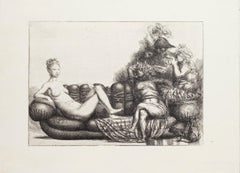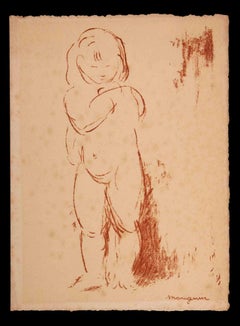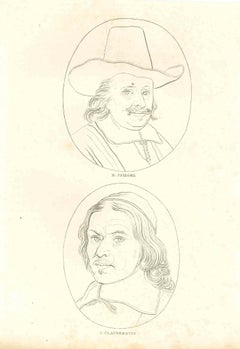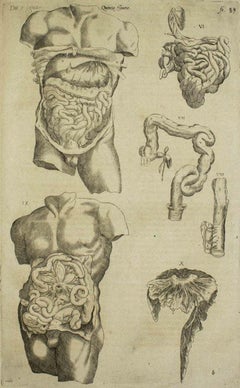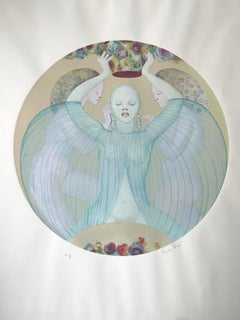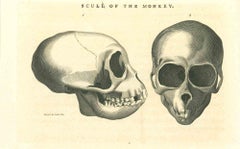Baby Figurative Prints
to
995
2,575
743
581
190
112
Overall Width
to
Overall Height
to
1,605
572
234
221
218
171
144
55
42
27
25
3
2
1
105
83
70
63
51
368
509
2,907
434
37
120
304
189
180
298
330
516
266
138
305
2,726
1,352
119
27,047
14,823
10,868
9,104
7,885
7,003
4,661
4,218
2,456
2,060
1,933
1,848
1,623
1,459
1,434
1,428
1,406
1,282
1,228
1,107
1,557
1,325
553
396
280
308
1,895
1,809
1,762
Art Subject: Baby
Venus - Etching by Riccardo Tommasi Ferroni - 1970s
Located in Roma, IT
Venus is a splendid etching artwork realized by the Italian artist Riccardo Tommasi Ferroni (1934-2000).
Not signed.
The state of preservation is very good.
Tommasi Ferroni's styl...
Category
1970s Figurative Prints
Materials
Etching
Child - Original Lithograph by Henri Charles Manguin - Early 20th Century
By Henri Charles Manguin
Located in Roma, IT
Child is an Original Litograph realized by Henri Charles Manguin (1874-1949).
The little artwork is in good condition, except for torn top edge....
Category
Early 20th Century Modern Figurative Prints
Materials
Lithograph
The Physiognomy - Portrait - Original Etching by Thomas Holloway - 181
Located in Roma, IT
The Physiognomy - Portrait is an original etching artwork realized by Thomas Holloway for Johann Caspar Lavater's "Essays on Physiognomy, Designed to Promote the Knowledge and the Lo...
Category
1810s Modern Figurative Prints
Materials
Etching
The Digestive System - De Humani Corporis Fabrica - by A. Vesalio - 1642
Located in Roma, IT
The Digestive System is an original etching realized as plate no.35 for the 1642 edition of the "De Humani Corporis Fabrica" by the italian anatomist ...
Category
1640s Modern Figurative Prints
Materials
Etching
Leonor Fini, rare original silkscreen on Rives paper, circa 1970
By Leonor Fini
Located in Saint Ouen, FR
Leonor Fini, rare original silkscreen on Rives paper, circa 1970
Rare print handsigned by surrealist artist Leonor Fini, inscreasingly esteemed with the movement of rediscovering ar...
Category
1970s Surrealist Figurative Prints
Materials
Paper
The Physiognomy - Skulls - Original Etching by Thomas Holloway - 1810
Located in Roma, IT
The Physiognomy - Skulls is an original etching artwork realized by Thomas Holloway for Johann Caspar Lavater's "Essays on Physiognomy, Designed to Promote the Knowledge and the Love...
Category
1810s Modern Figurative Prints
Materials
Etching
Nude Woman - Mixed Media on Cardboard by Leo Guida - 1970s
By Leo Guida
Located in Roma, IT
Nude Woman is an original mixed media on cardboard artwork by Leo Guida in the XX century.
The state of preservation is good except for some foxings.
Sheet dimension: 35 x 50
ONn...
Category
1970s Figurative Prints
Materials
Ink, Mixed Media, Watercolor
Mitosc Szesnatolatkow Vintage Poster - 1970
Located in Roma, IT
Mitosc Szesnatolatkow Vintage poster is an offset print on paper realized in 1970a.
Good condition and aged.
Print: Slavic Artist
Category
1970s Contemporary Figurative Prints
Materials
Paper, Offset
Portrait of Oedipus - Etching by Giacomo Manzù - 1968
Located in Roma, IT
The Portrait of Oedipus king is an original etching realized by Giacomo Manzù in 1968.
Racocin Press inc New York, Officina Bosoni Verona.
Numbered on the lower left. Ed. 38/105.
...
Category
1960s Modern Figurative Prints
Materials
Drypoint, Etching
(Four Women at Hat Store)
Located in New York, NY
This is such an interesting image. Are there 'Four women'? Is the head on the upper right from a hat store or is she another person in the scene. And what a...
Category
Mid-20th Century American Modern Figurative Prints
Materials
Etching
H.O. Miethke Das Werk folio "Water Snakes II" collotype print
Located in Chicago, IL
Water Snakes II, no. 9 from the fourth installment of Das Werk Gustav Klimts
The last painting Klimt exhibited with the Secession before resigning, Water ...
Category
Early 1900s Vienna Secession Figurative Prints
Materials
Paper
The Human Body - De Humani Corporis Fabrica - by Andrea Vesalio - 1642
Located in Roma, IT
The Human Body is a original etching realized as plate no. 33 of Andrea Vesalio's "De Humani Corporis Fabrica". The "De Humani Corporis Fabrica is comm...
Category
1640s Figurative Prints
Materials
Etching
The Thoughtful - Original Lithograph by F. Bac - 1922
Located in Roma, IT
The Thoughtful is an original modern artwork realized by Ferdinand Bac (1859 - 1952) in 1922.
Original Lithograph on ivory paper.
Signed and dated on plate on the lower left corner...
Category
1920s Art Nouveau Figurative Prints
Materials
Lithograph
Segno Zodiacale Acquario - Original Screen-Print by Sergio Barletta - 1973
Located in Roma, IT
Segno Zodiacale Acquario is an original screen print on grey paper realized by Sergio Barletta.
Signed on the lower left margin.
In good conditions e...
Category
1970s Contemporary Figurative Prints
Materials
Screen
Poster of Stowackiego Theater - Vintage Offset Poster - 1975
Located in Roma, IT
Poster of Stowackiego theater is an original offset print realized in 1975 for "Ulani".
Signed on the lower right " M. Gorowski 75".
Good conditions except for light and small cutt...
Category
1970s Figurative Prints
Materials
Offset
Horseman - Original Woodcut by Mino Maccari - Mid-20th Century
By Mino Maccari
Located in Roma, IT
"Horseman" is an original woodcut artwork realized by Mino Maccari (1898-1989).
In Good conditions, except for very small foxing along the margins which does not affect the image.
...
Category
Mid-20th Century Modern Figurative Prints
Materials
Woodcut
The Zero Hour / - After the End of the World -
Located in Berlin, DE
Rudolf Nehmer (1912 Bobersberg - 1983 Dresden), The Zero Hour, 1948. Woodcut on yellowish wove paper, 20 cm x 14.8 cm (image), 43 cm x 30 cm (sheet size), signed “Rud.[olf] Nehmer” i...
Category
1940s Realist Figurative Prints
Materials
Woodcut
Picasso, Minotaure blesse VI (after)
Located in Fairfield, CT
Artist: After Pablo Picasso (1881-1973)
Title: Minotaure blesse VI (Bloch 196)
Year: 1992
Medium: Reproduced from the original edition using the grain Autotype halftone screen process by Druck- und Verlag GmbH, 4200 Oberhausen, Germany; lithographically printed by Druck- und Verlag GmbH on japon handmade 200 g/sqm paper by created by Richard de Bas in Ambert, France and imported by Japico Drissler Feinpapiere, Frankfurt, Germany.
Paper Size: 18 x 12.75 inches; a size slightly reduced from the original Vollard edition for differentiation
Condition: Excellent
Inscription: Artist’s signature posthumously lithographically reproduced from the original Vollard edition, and numbered in pencil by the curators of the Municipal Museum Mülheim an der Ruhr, Germany. 168/300.
Notes: Published by Municipal Museum Mülheim an der Ruhr, Germany in cooperation with the Society for the Promotion of the museum in 1992 and the Fundación Picasso; printed by Plitt Druck- und Verlag GmbH, 4200 Oberhausen, Germany. The following is a German to English translation of the original text issued by the Municipal Museum Mülheim an der Ruhr, Germany in the following from which this graphic is a part, “In order to give a broad public access to this unique print work by Pablo Picasso in its entirety and at the highest quality level, the support group for the city. Museum Mülheim an der Ruhr initiated and significantly supported the new edition of the “Suite Vollard.” The reprint of the "Suite Vollard" includes a limited edition of 300 copies of 100 loose sheets each in a linen cassette. The copies were numbered from 1 to 300 on the leader sheet. The reproductions were produced in grain screen mode, a process in which which eliminates the traditional line grid and achieves maximum originality. The paper was hand-made specifically for this work by Richard de Bas in Ambert, France, one of the most traditional paper mills in Europe. The paper for the original edition also comes from this factory. The quality Blane narcisse, belin, 200 g/sqm was selected and imported from Japico Drissler Feinpapiere, Frankfurt. Reproduction and paper format has been slightly reduced compared to the original edition. The technical development and overall production was carried out by Plitt Druck- und Verlag GmbH, 4200 Oberhausen.”
PABLO PICASSO (1881-1973) Spanish painter and sculptor is one of the most recognized figures of twentieth century art. During his artistic career, which lasted more than 75 years, he created thousands of works using all kinds of mediums. He changed art more profoundly than any other artist of his time. First famous for pioneering cubism...
Category
1990s Cubist Nude Prints
Materials
Lithograph
$3,400 Sale Price
20% Off
Arnold Ronnebeck 1930s Lithograph – Grand Lake Colorado Yacht Races, WPA Era
Located in Denver, CO
This striking vintage 1930s black-and-white lithograph by celebrated Colorado artist Arnold Ronnebeck (1885–1947) captures the dynamic energy of the Grand Lake...
Category
1930s American Modern Landscape Prints
Materials
Lithograph
Headache, Stomachache
Located in Palm Springs, CA
While the images have some resemblance to traditional Japanese Ukiyo-e prints, their sense of whimsy, satire and irony relate more closely to contemporary life and western sensibilit...
Category
2010s Contemporary Figurative Prints
Materials
Etching, Aquatint
Collection of Various Black and White and Colour Woodcuts
Located in Roma, IT
Original editorial soft cover with dowel on front plate. Nice collection of original fine woodcuts of the Utagawa school, partially coloured, including illustrations of Japanese thea...
Category
Early 19th Century Modern Figurative Prints
Materials
Woodcut
Alexander Calder Lithograph Derriere le miroir (Calder prints)
Located in NEW YORK, NY
Vintage original Alexander Calder Three Legged Man Lithograph 1975:
Lithograph in colors. 15 x 11 inches.
Very good overall vintage condition.
Unsigned from an edition of unknown.
...
Category
1970s Contemporary Figurative Prints
Materials
Lithograph
$240 Sale Price
39% Off
Picasso, Composition (Orozco 193-204), Au Baiser D'Avignon (after)
Located in Southampton, NY
Lithograph on vélin d’Arches paper. Signed in the plate and unnumbered, as issued. Good condition. Notes: From the folio, Picasso au baiser d'Avignon, douze dessins, lavis, aquarelle...
Category
1970s Cubist Figurative Prints
Materials
Lithograph
$3,596 Sale Price
20% Off
Untitled - Lithograph by Ermanno Iaia - 1990
Located in Roma, IT
Lithograph on Magnani-Pescia paper. Paper size 50cmx70cm, work size 60cmx40cm. Excellent condition, no defects. lithograph hand colored
Ermanno Iaia - Born in Rome in 1933,
He atte...
Category
1990s Contemporary Figurative Prints
Materials
Lithograph
DAVID HOCKNEY 1989 - 1990 Metropolitan Museum of Art Exhibition Original Poster
Located in Pasadena, CA
David Hockney,
Print Lithograph, Framed with a custom wood frame .
Size is Framed
David Hockney ( B. 1937 ) is an English painter, draftsman, printmaker, stage designer, and photogra...
Category
Late 20th Century Contemporary Portrait Prints
Materials
Color
Torse, Fond à Losanges - Drypoint on China by H. Matisse, 1929
Located in Roma, IT
Image size: 8.6x13.9 cm.
Original drypoint on Chine Appliqué realized by Matisse in 1929 in an edition of only 25 prints.
Signed and numbered in pencil lower right.
Excellent conditi...
Category
1920s Fauvist Figurative Prints
Materials
Drypoint
Marc Chagall - Creation - Adam and Eve - Original Lithograph from Bible
By Marc Chagall
Located in Collonge Bellerive, Geneve, CH
Marc Chagall, Original Lithograh depicting an instant of the Bible.
Technique: Original lithograph in colours (Mourlot no. 234)
On the reverse: another black and white original litho...
Category
1960s Modern Figurative Prints
Materials
Lithograph
Annunciation Scene
Located in Paris, Île-de-France
Pierre-Mathieu Ogier (active between 1676 and 1709)
Annunciation Scene
Engraved copper plate, dated 1691
17.5 x 11.2 cm
Provenance:
Private collection, France
This engraved copper...
Category
17th Century Old Masters Figurative Prints
Materials
Copper
Etude de Main, Cubist Lithograph after Pablo Picasso
Located in Long Island City, NY
Floating against a brown background, the three hands in this Pablo Picasso print are disembodied and dimensional. Illuminated with light from above, the hands are shown realistically...
Category
Late 20th Century Cubist Figurative Prints
Materials
Lithograph
20th century woodcut ink black and white figures musical instruments dramatic
Located in Milwaukee, WI
"Chamber Music" is an original wood engraving by Robert Franz von Neumann. It features a room full of men in the thralls of creating music together. A small audience stands outside their circle.
Image: 5.5" x 7"
Framed: 14" x 15.56"
1888 - 1976 Born in Rostock, Mecklenburg, Germany, Robert von Neumann...
Category
1930s American Modern Figurative Prints
Materials
Woodcut
Pillow Painting, Pop Art Screenprint by Hunt Slonem 1980
By Hunt Slonem
Located in Long Island City, NY
This serigraph was created by contemporary American artist Hunt Slonem. Slonem is best known for his Neo-Expressionist paintings and bright tropical palette, and his subject matter o...
Category
1980s Contemporary Figurative Prints
Materials
Screen
Original Baby in bidet - Manifattura Ceramica Pozzi vintage Italian poster
Located in Spokane, WA
Original poster showing a “Baby in a Bidet”. In Italian it is Maniffatura Ceramica Pozzi. Linen backed in very fine condition, ready to frame. This Italian poster was only know...
Category
1950s American Modern Portrait Prints
Materials
Offset
"Love on the Roof" American Realist Etching
By John Sloan
Located in Austin, TX
By John Sloan
American Realist
From the early 20th century Ashcan School which focused on capturing day to day life in New York City during that period.
Image size: 5.75" x 4.25"
Et...
Category
Early 20th Century American Realist Figurative Prints
Materials
Archival Paper, Etching
Picasso, 8.10.64. III (Cramer 148), Le Goût du Bonheur (after)
Located in Southampton, NY
Lithograph and silkscreen with grease crayon, lithographic tusche, lead pencil, charcoal on vélin d'Arches paper. Paper size: 12.8 x 9.84 inches. Inscription: Unsigned and unnumbered...
Category
1970s Cubist Figurative Prints
Materials
Lithograph
$796 Sale Price
20% Off
Les Deux Matrones, Art Nouveau Etching by Georges Rouault
Located in Long Island City, NY
Artist: Georges Rouault, French (1871 - 1958)
Title: Les Deux Matrones from Le Reincarnations du Pere Ubu
Year: 1928
Medium: Aquatint on Arches, signed in the...
Category
1920s Expressionist Figurative Prints
Materials
Aquatint
Athletes, Impressionist Lithograph by Sandro Chia
By Sandro Chia
Located in Long Island City, NY
Artist: Sandro Chia, Italian (1946 - )
Title: Athletes
Year: 1988
Medium: Lithograph, signed and numbered in pencil
Edition: 300
Image Size: 29.5 x 21.5 inches
Paper Size: 34 in. x ...
Category
1980s Pop Art Figurative Prints
Materials
Lithograph
Interiors VI: Soundings
By Peter Milton
Located in New York, NY
Contemporary artist Peter Milton created this etching and engraving entitled "Interiors VI: Soundings" in 1989. The printed image size is 29 7/8 x 23 13/16 and paper size is 36 x 29 inches. This impression is signed, dated, and titled in pencil and inscribed “93/175” – the 93 impression of 175.
“I do love to draw. I feel that I am being granted membership in the Brotherhood of Merlin, conjuring forth some apparition. As a drawing develops, I sense a vague presence coming more and more into focus, something in a white fog emerging and becoming increasingly palpable.” – P. Milton, “The primacy of touch. The Drawings of Peter Milton”
“Working in layers, Milton begins with drawings based on people and places, with nods to Western art history and culture. He is a master of the appropriated image, a term that may conjure Andy Warhol and his Pop Art comrades. But Milton steps further back in history, avoiding the Pop sense of cool advertising and popular culture references. Instead, a broader cultural past is tapped through historical photographs of key players, architecture, and locales, which he reinvents by hand. He adds content drawn from his life as an avid reader – always with multiple possible interpretations – thus incorporating deeper meaning in his cinematic worlds. Elements of Greek mythology, classical music, art history, and history coalesce in his images, which embrace the messiness, sorrow, and elation that is life. One is hard-pressed to imagine a more erudite, skilled, passionate, and cheeky soul."
– T. L. Johnson and A. Shafer
Peter Milton was born in Pennsylvania in 1930. He studied for two years at the Virginia Military Institute...
Category
Late 20th Century Surrealist Interior Prints
Materials
Engraving, Etching
18th-century celestial - Andromeda Perseus Triangulum
Located in London, GB
18th-century celestial
FLAMSTEED, John.
Andromeda Perseus Triangulum
London, C. Nourse, 1753.
A fine star chart from the Atlas Coelestis, the largest and most accurate star atlas ...
Category
1750s Naturalistic Figurative Prints
Materials
Watercolor, Engraving
E. Strache, Handzeichnungen folio, "Kneeling Female Nude" Collotype plate
Located in Chicago, IL
after Egon Schiele (1890 – 1918), AUSTRIA
“ART CANNOT BE MODERN, ART IS PRIMORDIALLY ETERNAL.” -SCHIELE
Defiantly iconoclastic in life and art, Egon Schiele is esteemed for his mas...
Category
1920s Vienna Secession Figurative Prints
Materials
Paper
Titre pour "Le Sourire"
By Paul Gauguin
Located in London, GB
Paul Gauguin
Titre pour "Le Sourire"
1899
Woodcut
Paper size 13.8 x 21.9 cms (5 1/2 x 8 5/8 ins)
Image size 10.5 x 20.8 cms (4 1/8 x 8 1/8 ins)
Kornfeld 61
Signed in lower left corn...
Category
1890s Figurative Prints
Materials
Woodcut
Original Pink Panther Supporting Characters, Production Cel/Drawing
By MGM Studios
Located in Fairfield, CT
Artist: MGM Studios
Title: Pink Panther, Supporting Characters
Year: 1993-1995
Medium: Original, hand-painted production animation cel with laser color background, plus pencil drawin...
Category
1990s Pop Art Figurative Prints
Materials
Ink, Acrylic
Pierrot avec Parapluie, Surrealist Etching by Marc Chagall
By Marc Chagall
Located in Long Island City, NY
Marc Chagall, Russian (1887 - 1985) - Pierrot avec Parapluie, Year: 1927, Medium: Etching and Aquatint on Richard de Bas, Image Size: 14.25 x 11.5 inches, Size: 22 x 16 in. (55.88 ...
Category
1920s Surrealist Figurative Prints
Materials
Etching
Mother and Child, by Jiang Tie-Feng
Located in Palm Springs, CA
Mother and Child
Artist: Jiang Tiefeng
Medium: Color Serigraph
Image Size: 36 x 36 inches
Signature: Signed in pencil
Date: 2000
Edition: 141/300
The print Mother and Child by the C...
Category
1980s Contemporary Figurative Prints
Materials
Screen
$1,500 Sale Price
25% Off
PETIT SONNET
Located in Aventura, FL
Serigraph in colors on paper. Hand signed and numbered by Linda Le Kinff. From the edition of 350. Sheet size 18.5 x 15 inches. Image size 16 x 12.5 inches.
Artwork is in exc...
Category
1990s Contemporary Portrait Prints
Materials
Paper, Screen
$600 Sale Price
40% Off
Picasso, 20.5.64. VII (Cramer 148), Le Goût du Bonheur (after)
Located in Southampton, NY
Lithograph and silkscreen with grease crayon, lithographic tusche, lead pencil, charcoal on vélin d'Arches paper. Paper size: 12.8 x 9.84 inches. Inscription: Unsigned and unnumbered...
Category
1970s Cubist Figurative Prints
Materials
Lithograph
$956 Sale Price
20% Off
Women of Intellect #6, Folk Art Lithograph by Estelle Ginsburg
Located in Long Island City, NY
Artist: Estelle Ginsburg, American
Title: Women of Intellect #6
Year: 1978
Medium: Lithograph, signed and numbered in pencil
Edition: 150
Size: ...
Category
1970s Expressionist Figurative Prints
Materials
Lithograph
Pablo Picasso, L'Atelier du vieux peintre
Located in Chatsworth, CA
This piece is an original lithograph in five colors by Pablo Picasso, created in 1954. Each of the 5 colors of this lithograph was executed with litho crayon on transparent transfer...
Category
1950s Post-Impressionist Figurative Prints
Materials
Lithograph
Lisa Yuskavage, Night Flowers - Signed Print
Located in Hamburg, DE
Lisa Yuskavage (American, b. 1962)
Night Flowers (from Exit 99: Exit Art Portfolio), 1999
Medium: Etching and aquatint on grey wove paper
Dimensions: 56 × 68 cm (22 × 26⅞ in)
Edition...
Category
20th Century Contemporary Figurative Prints
Materials
Etching, Aquatint
Shunga: Twelve Signs of the Zodiac - Goat
Located in Fairlawn, OH
Shunga: Twelve Signs of the Zodiac - Goat
Color woodcut with gauffrage (embossing)
Unsigned (as usual)
Format: Shikishiban
Publisher: Privately produced
Unusually well preserved with the fugitive blue still intact
Image size: 5-1/8 x 5-3/4"
Sheet size: 5 3/8 x 6 1/4"
From Wikipedia, the free encyclopedia
In this Japanese name, the surname is Isoda.
Isoda Koryūsai (礒田 湖龍斎, 1735–1790) was a Japanese ukiyo-e print designer and painter active from 1769 to 1790.
Life and career
Koryūsai was born in 1735 and worked as a samurai in the service of the Tsuchiya clan. He became a masterless rōnin after the death of the head of the clan and moved to Edo (modern Tokyo) where he settled near Ryōgoku Bridge in the Yagenbori area. He became a print designer there under the art name Haruhiro in 1769, at first making samurai-themed designs. The ukiyo-e print master Harunobu died in 1770, and about that time Koryūsai began making prints in a similar style of life in the pleasure districts.
Koryūsai was a prolific designer of individual prints and print series,[1] most of which appeared between 1769 and 1881.
In 1782, Koryūsai applied for and received the Buddhist honour hokkyō ("Bridge of the Law") from the imperial court and thereafter used the title as part of his signature. His output slowed from this time, though he continued to design prints until his death in 1790.
Works
Koryūsai created a total of 2,500 known designs, or an average of four a week. According to art historian Allen Hockley, "Koryūsai may ... have been the most productive artist of the eighteenth century".
The series Models for Fashion: New Designs as Fresh Young Leaves (Hinagata wakana no hatsumoyō, 1776–1781) ran for 140 prints, the longest known ukiyo-e print series of beauties. He designed at least 350 hashira-e pillar prints, numerous kachō-e bird-and-flower prints, a great number of shunga erotic prints, and others. Ninety of his nikuhitsu-ga paintings are known, making him one of the most productive painters of the period.
Legacy
Despite Koryūsai's productivity and popularity—both in his time and amongst later collectors—his work has attracted little scholarship. The first ukiyo-e histories written in the West in the 19th century elevated certain artists as exemplars; Koryūsai's work came to be seen as too indebted to Harunobu, who died in 1770, and inferior to that of Kiyonaga, whose peak period came in the 1880s. An example is Woldemar von Seidlitz's Geschichte des japanischen Farbenholzschnittes ("History of Japanese colour prints", 1897), the most popular of the early ukiyo-e histories, which paints Koryūsai as a successor to Harunobu and a rival of Kiyonaga in the 1770s who slipped into mediocrity and imitation of his rival by the end of the decade.[5] Interest lay mainly in the details of Koryūsai's life—a samurai who received court honours was unusual in the proletarian world of ukiyo-e. In 2021, contemporary woodblock printmaker David Bull...
Category
1770s Other Art Style Figurative Prints
Materials
Woodcut
Plate 3 (Derriere le Miroir # 212)
Located in Washington, DC
Alexander Calder Plate 3 (Derriere le Miroir # 212)
Artist: Alexander Calder
Medium: Original lithograph in colors
Title: Plate 3
Portfolio: Derriere le M...
Category
1970s Figurative Prints
Materials
Lithograph
Picasso, Sculpteur au Repos avec Modèle démasqué et sa Représentation (after)
Located in Fairfield, CT
Artist: After Pablo Picasso (1881-1973)
Title: Sculpteur au Repos avec Modèle démasqué et sa Représentation sculptée (after Bloch 159)
Year: 1992
Medium: Reproduced from the original...
Category
1990s Cubist Nude Prints
Materials
Lithograph
$2,920 Sale Price
20% Off
Patitcha
Located in London, GB
Henri Matisse
Patitcha
1947
Aquatint on BFK Rives paper, Edition of 25
Paper size: 55.5 x 38 cms (22 x 15 ins)
Image size: 34.9 x 27.6 cm (13 3/4 x 10 7/8 ins)
HM15405
Selected Coll...
Category
1940s Modern Figurative Prints
Materials
Aquatint
$100,000
Toulouse-Lautrec, Composition, The Circus by Toulouse-Lautrec (after)
Located in Fairfield, CT
Medium: Lithograph on vélin paper
Year: 1952
Paper Size: 12.125 x 9.25 inches
Inscription: Unsigned and unnumbered, as issued
Notes: From the album, The Circus by Toulouse-Lautrec, 1...
Category
1950s Post-Impressionist Figurative Prints
Materials
Lithograph
$716 Sale Price
20% Off
UNTITLED [GENTLEMAN OBSERVING BILLIARDS GAME].
Located in Portland, ME
Brinton, D. UNTITLED [GENTLEMAN OBSERVING BILLIARDS GAME]. Drypoint, n.d. (c. early to mid-20th Century). 8 x 6 inches (image), 11 1/2 x 8 inches (sheet). In excellent condition, wit...
Category
Early 20th Century Figurative Prints
Materials
Drypoint
Ballet und Pantomime "Der Tanzende Gott" (The Dancing God), plate #14.
Located in Chicago, IL
Walter Schnackenberg’s style changed several times during his long and successful career. Having studied in Munich, the artist traveled often to Paris where he fell under the spell o...
Category
1920s Art Deco Figurative Prints
Materials
Paper
H.O. Miethke Das Werk folio "Death and Life" collotype print
Located in Chicago, IL
DAS WERK GUSTAV KLIMTS, a portfolio of 50 prints, ten of which are multicolor collotypes on chine colle paper laid down on hand-made heavy cream wove paper with deckled edges; under ...
Category
Early 1900s Vienna Secession Figurative Prints
Materials
Paper
George's Car Wash, Pop Art Screenprint by Seymour Chwast
Located in Long Island City, NY
Artist: Seymour Chwast, American (1931 - )
Title: George's Car Wash
Year: Circa 1978
Medium: Screenprint, signed and numbered in pencil
Edition: 250, AP 50
Image Size: 30.5 x 23 ...
Category
1970s Pop Art Figurative Prints
Materials
Screen
Sous la Tente, Sur la Plage, Bionville
Located in Boston, MA
Jacques Villon, American (1875-1963), Sous la Tente, Sur la Plage, Bionville, circa 1905. Ginestet Pouillon 137. Trial proof in color outside of the edition of 50. With blindstamp in...
Category
Early 1900s Impressionist Figurative Prints
Materials
Aquatint
Toulouse-Lautrec, Composition, TLautrec (after)
Located in Fairfield, CT
Medium: Lithograph and stencil on vélin paper
Year: 1946
Paper Size: 17 x 13 inches
Inscription: Signed in the plate and unnumbered, as issued
Notes: From the folio, TLautrec, 1946. ...
Category
1940s Post-Impressionist Figurative Prints
Materials
Lithograph
$716 Sale Price
20% Off
Marc Chagall - The Bible - Original Lithograph
By Marc Chagall
Located in Collonge Bellerive, Geneve, CH
Marc Chagall, Original Lithograph depicting an instant of the Bible.
Technique: Original lithograph in colours
Year: 1956
Sizes: 35,5 x 26 cm / 14" x 10.2" (...
Category
1950s Modern Figurative Prints
Materials
Lithograph
